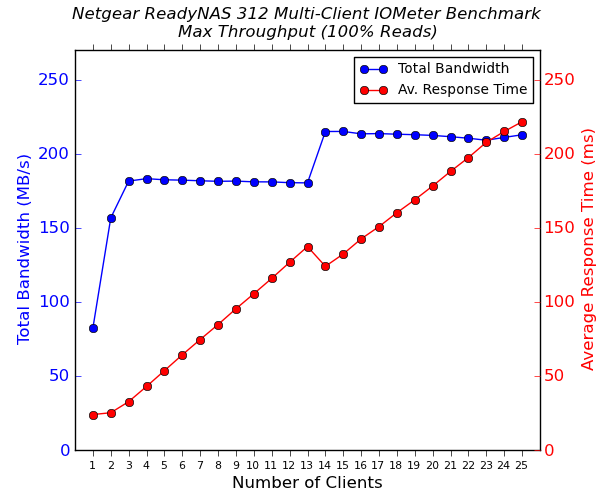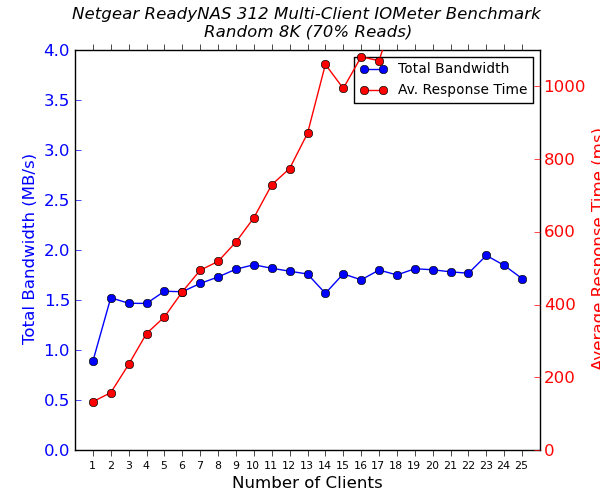Netgear ReadyNAS 312 2-bay SMB / SOHO NAS Review
by Ganesh T S on November 11, 2013 1:00 PM EST- Posted in
- NAS
- IT Computing
- NetGear
- ReadyNAS
Multi-Client Performance - CIFS
We put the ReadyNAS 312 through some IOMeter tests with a CIFS share being accessed from up to 25 VMs simultaneously. The following four graphs show the total available bandwidth and the average response time while being subject to different types of workloads through IOMeter. IOMeter also reports various other metrics of interest such as maximum response time, read and write IOPS, separate read and write bandwidth figures etc. Readers interested in the actual values can refer to our evaluation metrics table available here.




Since this is the first 2-bay unit that we are publishing benchmarks for with the new testing methodology, we don't have graphs for comparison, but, rest assured, upcoming reviews of NAS units with similar number of bays will see comparison graphs available for reference.










18 Comments
View All Comments
anactoraaron - Monday, November 11, 2013 - link
The only thing that I would add is that Netgear is really taking their ReadyNAS product line seriously with their support. I reviewed on of these units as well (mine came with 2x 1TB Toshiba drives included) and I had some very strange issues with the software (6.0.8). Without going into the details (ejecting external usb drives was one), I notified Netgear about the issue they had a firmware fix the next Monday (firmware was originally 6.0.8 - and was updated to 6.1.1). To me, that was a huge plus. Knowing that your support ticket,etc would be investigated and getting such a fast patch issued shows their commitment to this product line.jaydee - Monday, November 11, 2013 - link
Ganesh,I'm wondering how likely is it, if you were to buy/use this in a home, to actually use the OS that comes with the system, rather than WHS 2011, or a Linux-based server OS (CentOS, etc)? Can you go a bit further with the software aspect of it?
anactoraaron - Monday, November 11, 2013 - link
I would just use the OS that comes with it. There's other features of the OS (like Power Timer) that allow you to set a schedule for when the NAS is on - and it also has WOL functionality. Inside the OS is support for SMB, AFP, NFS, FTP, iTunes, ReadyDLNA, etc. Also in the OS is a free antivirus.There's also a one touch backup button that can be configured to whatever you want to backup (like just certain shared folders) or you can schedule automatic backups. There's nothing too special about the OS, but there's really nothing missing from it either.
ganeshts - Monday, November 11, 2013 - link
I agree with anactoraaron. This is an off-the-shelf NAS. If the software features don't fit, you are better off with a WHS server or custom Linux DIY build. Also, as far as I can see, the only complaint that can be put forward 'core-feature-wise' is the lack of LVM support -- i.e, say, you get the 4-bay variant and want to store some data with single disk resiliency and some with dual disk resiliency -- it is not possible with ReadyNAS OS 6.x.tuxRoller - Monday, November 11, 2013 - link
BTRFS includes "lvm" just as zfs does. In fact, that's one of its criticisms.Since btrfs supports redundancy using the chunks model (default 256MB), rather than at the disk level, you can have multiple redundancy options within a single disk (not a great idea for multiple reasons, but should be doable). Of course, you can span this over multiple disks to get the desired effect.
Something like:
mkfs.btrfs -m raid 1 -d /dev/sda -d raid 1 /dev/sdb /dev/sdc
I should think.
ganeshts - Monday, November 11, 2013 - link
I did mention btrfs's LVM support in the article, but the problem is that Netgear's firmware doesn't implement it.tuxRoller - Monday, November 11, 2013 - link
In the article you said it was supposed to be using the code that was employed in Oracle's deployments?ganeshts - Monday, November 11, 2013 - link
Yes, but not all features are exposed to the end-users. I guess the really adventurous users could try out certain things over SSH, but without official support, it is going to be pretty dangerous.jaydee - Monday, November 11, 2013 - link
The feature I had in mind was proxy server for web caching, content filter, security (something like Squid). I realize this is kinda getting away from a "NAS", but with the specs listed, I don't see why it couldn't.bsd228 - Monday, November 11, 2013 - link
While Oracle may now include it, Redhat is still on the fence about it with the upcoming RHEL7, and still is working out stability before endorsing it for performance reasons. If you want a better filesystem, you can get an HP Microserver and pair it with zfs. I'll let others take this netgear experiment.